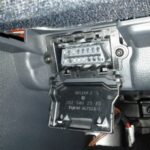The F1804 Obd2 code is a common diagnostic trouble code (DTC) that can occur in various vehicle makes and models. While this code may seem complex, understanding its meaning and potential causes can help you address the underlying issue effectively. This article provides a comprehensive overview of the F1804 code, including its definition, common symptoms, possible causes, diagnostic procedures, and potential solutions. While this article provides general information, always consult your vehicle’s specific repair manual for detailed instructions and safety precautions.
What Does the F1804 Code Mean?
The F1804 OBD2 code typically signifies a fault within the Engine Control Module (ECM) or Powertrain Control Module (PCM) communication network. It specifically indicates a problem with the communication between the ECM/PCM and other control modules within the vehicle, often related to the CAN (Controller Area Network) bus system. The CAN bus is a crucial communication network that allows various modules, such as the transmission control module, ABS module, and body control module, to exchange data and operate seamlessly.
Common Symptoms of the F1804 Code
The F1804 code can manifest in a variety of ways, ranging from subtle performance issues to more noticeable drivability problems. Some common symptoms associated with this code include:
- Check Engine Light Illumination: The most common symptom is the illumination of the check engine light on the vehicle’s instrument panel.
- Rough Engine Running: The engine may run rough or experience misfires due to communication issues affecting ignition timing or fuel delivery.
- Reduced Engine Power: A noticeable decrease in engine power or acceleration may occur.
- Transmission Shifting Problems: The transmission may shift erratically or experience harsh shifts due to communication disruptions.
- Other Warning Lights: Other warning lights, such as the ABS or traction control light, may illuminate if the communication issue affects related systems.
Possible Causes of the F1804 Code
Several potential causes can trigger the F1804 code. Identifying the root cause is crucial for effective repair. Common causes include:
- Wiring Issues: Damaged, corroded, or loose wiring within the CAN bus system can disrupt communication between modules. This includes open circuits, short circuits, and poor connections.
- Faulty Control Modules: A malfunctioning ECM/PCM or other control module connected to the CAN bus can cause communication errors.
- Low Battery Voltage: Insufficient battery voltage can disrupt the proper functioning of the ECM/PCM and other modules, leading to communication problems.
- Blown Fuses: A blown fuse related to the ECM/PCM or CAN bus system can interrupt power supply and communication.
Diagnosing the F1804 Code
Diagnosing the F1804 code requires a systematic approach using appropriate diagnostic tools. Typical steps include:
- Retrieving Diagnostic Trouble Codes (DTCs): Using an OBD2 scanner, retrieve all stored DTCs to identify the F1804 code and any other related codes.
- Visually Inspecting Wiring and Connectors: Thoroughly inspect the wiring harness and connectors associated with the CAN bus system for any visible damage, corrosion, or loose connections.
- Checking Battery Voltage: Verify that the battery voltage is within the specified range.
- Testing CAN Bus Communication: Using a diagnostic scanner with CAN bus capabilities, test the communication network for any abnormalities or errors.
- Testing Individual Modules: If necessary, test individual control modules to determine if a specific module is faulty.
Potential Solutions for the F1804 Code
The solution for the F1804 code depends on the underlying cause. Common solutions include:
- Repairing or Replacing Wiring: Repair or replace any damaged, corroded, or loose wiring within the CAN bus system.
- Replacing Faulty Modules: If a control module is determined to be faulty, replace it with a new or remanufactured unit.
- Addressing Battery Voltage Issues: Charge or replace the battery if the voltage is low. Address any underlying charging system problems.
- Replacing Blown Fuses: Replace any blown fuses related to the ECM/PCM or CAN bus. Determine the cause of the blown fuse before replacement.

